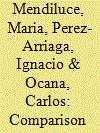| Srl | Item |
| 1 |
ID:
093541


|
|
|
|
|
| Publication |
2010.
|
| Summary/Abstract |
Energy intensity in Spain has increased since 1990, while the opposite has happened in the EU15. Decomposition analysis of primary energy intensity ratios has been used to identify which are the key sectors driving the Spanish evolution and those responsible for most of the differences with the EU15 energy intensity levels. It is also a useful tool to quantify which countries and economic sectors have had most influence in the EU15 evolution. The analysis shows that the Spanish economic structure is driving the divergence in energy intensity ratios with the EU15, mainly due to strong transport growth, but also because of the increase of activities linked to the construction boom, and the convergence to EU levels of household energy demand. The results can be used to pinpoint successful EU strategies for energy efficiency that could be used to improve the Spanish metric.
|
|
|
|
|
|
|
|
|
|
|
|
|
|
|
|
| 2 |
ID:
107507


|
|
|
|
|
| Publication |
2011.
|
| Summary/Abstract |
This paper contributes to the debate about climate change technology transfer by analysing barriers and enablers for a Chilean company starting up the production of wind blades. Literature on the role of technology transfer for the development and deployment of local renewable energy technologies in developing countries often refers to success stories in Brazil, India and China. Instead, this case study highlights the different challenges faced by smaller emerging economies. The paper argues that successful technology transfer in a smaller economy like Chile requires: a minimum internal demand and access to regional markets to attract foreign knowledge providers; a focus in the types of technologies where the recipient country or company have a competitive advantage; and active learning processes by the recipient company. Lessons are drawn for improving the design and implementation of technology-push and market-pull policies in small or medium emerging economies.
|
|
|
|
|
|
|
|
|
|
|
|
|
|
|
|
| 3 |
ID:
109687


|
|
|
|
|
| Publication |
2011.
|
| Summary/Abstract |
This paper provides for the first time a complete analysis of recent trends in activity, carbon emissions, modal shares, energy intensities, vehicle use and fuels in the Spanish transport system from 1990 to 2008 and discusses policy options. Passenger and freight activities have increased in Spain and are projected to continue, presenting a challenge for sustainable mobility efforts; emissions have increased, mainly fueled by the rise in activity; modal shares have pulled away from public transport, with a decrease in bus and rail, towards an increase in car and air travel; energy intensities, though initially decreasing, are currently increasing; and fuel use has taken over 37% of Spanish final energy consumption.
To target these issues the Spanish government has focused its efforts in targeting energy efficiency through dieselization, which has not led to positive results. More recently policies and measures have been directed towards redirecting modal shares and diversifying the fuel mix. Little has been done to reduce activity besides some anecdotic public awareness campaigns. Activity reduction may be achieved with regulations, restrictions and mobility plans; by increasing high speed rail and rail freight transport; by improving intermodality and tying the Spanish rail network with the EU; and with more urban transport planning at local level.
|
|
|
|
|
|
|
|
|
|
|
|
|
|
|
|